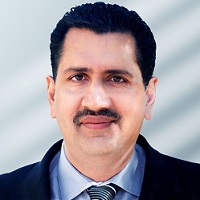 By Raj Toleti, Senior Vice President & General Manager, FollowMyHealth
By Raj Toleti, Senior Vice President & General Manager, FollowMyHealth
Twitter: @FMHMobile
Twitter: @rtoleti
It could be said that we’re in the midst of the perfect storm. As technology and data evolve so do most everything they touch. Those who can harness this evolution are finding both empowerment of systems and those they lead. I’ve seen inspired leaders take the reins of strategic thinking around innovation and the power of data, to new solutions and roles within the organization.
It’s a time of opportunity, especially in healthcare, for all stakeholders. As care delivery is redefined so are the roles of those responsible for facilitating it. From clinicians to technology professionals, it’s a time for creative leaders to emerge. It’s been inspiring to witness our CIO and CTO clients evolve their roles beyond technology implementation to become more forward-thinking strategic innovators who harness data to improve healthcare delivery through changing regulations, organizational goals, patient expectations and physician needs.
At the Core of Healthcare Transformation
As the evolution of data, healthcare and technology converge, empowerment is flourishing, and the CIO and CTO are at the center of this empowerment. These are now two of the most critical roles in transforming the “health” of the healthcare system.
With data as one of the most valuable assets in healthcare and value-based care taking center stage, those who can strategically harness it and put it to work to improve access to quality care and engage patients hold the keys to the future of healthcare. As quality care becomes more dependent on the availability of quality data, the role of the CIO has evolved into one of strategy and has become mission critical to care delivery. They are transforming care delivery models and engaging with more of a “consumer mindset.” To effectively make productive decisions they must have a deep understanding of all their stakeholders’ needs and expectations; particularly their expectations of well-designed mobile engagement.
Future-Focused Strategy
Today’s CIOs have the complex responsibility of being rooted in the present to address tactical needs; with a constant focus on predicting future needs. While the future is unknown; what is known is that they must build today’s technology with the ability to scale for unforeseen future needs. A strong strategy moves away from patchwork apps and point solutions to a scalable enterprise wide cloud-based infrastructure that can accommodate future changing needs and priorities by adding features on-demand post implementation.
The rule changes around Medicare Advantage this year reinforce that the transition from fee-for-service to value-based care is here to stay and will reach far and wide. Successful health systems will need to prepare to engage patients with quality care for improved outcomes and they will need a scalable patient engagement strategy to empower patients to stay at the center of their care.
It all starts with strategy. The best CIOs I know have a deployment roadmap that employ a phased approach to elicit stakeholder buy-in at every stage, ultimately well-positioning them for the future.
Understanding Behavior Change and Buy-In
When implementing new technology, no matter how smart it may be, it’s important to build in strategy that drives adoption and accommodates resistance to behavior change. Often a phased approach works best, starting with simple changes that result in immediate satisfaction for all stakeholders.
Deploying technology like patient reminders and mobile check-ins are an easy first-step with patient engagement technology. These are relatively easy lifts for the CIO and their staff yet yield high satisfaction for patients and clinicians. This allows the technology team to lay the groundwork and build up to more sophisticated patient engagement solutions such as self-scheduling and care management such as point-of-care assessments that integrate with the EHR and facilitate better decision making in real-time.
The future of healthcare is evolving but one thing is certain, navigating this perfect storm will hinge on the successful adoption of new patient-centric technology, squarely placing the CIO and CTO at the heart of its success.
